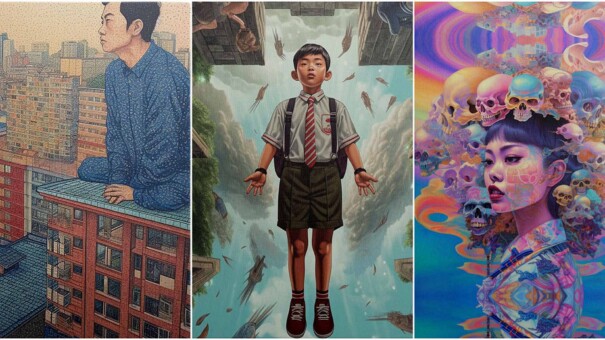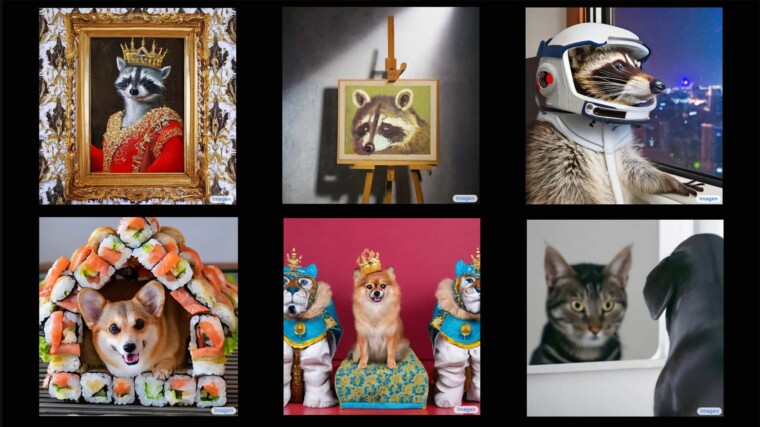Ever wondered how ‘A cute corgi living in a house made of sushi’ would look like? With AI-generated art, all you need is a prompt for your imagination to come alive.
How our relationship with art has evolved
Art has the power to connect. Whether it’s Van Gogh’s paintings depicting his inner world or Monet’s impressionist paintings, each has a story to tell – of emotions and cultural significance. The democratisation of art through AI is revolutionising how we create and appreciate artistic expressions.
AI-powered tools, like DALL-E and Midjourney, have made it so much easier for individuals without formal artistic training to experiment and create pixel-perfect images. The most amazing thing is how each image can be generated within seconds while still having that novelty.
The backend system has seen millions of pictures of the same tagged words which is how the magic happens. We see resemblance of what we wish for as the dataset closely links with the prompts and combinations we want. This outlet allows both the young and old to experiment and as a fun way to connect and destress.
Being able to visualise hidden feelings that may be difficult to verbalise in words also provides an outlet and a voice. With diverse people engaging in image creation, it also builds a conducive community for
inspiration and artistic exchange.

In the recent collaboration between R/GA and the Singapore Association for Mental Health (SAMH), the first generative AI exhibition, ‘Prompting Feelings’, it depicts what living with mental health disorders is like.
Saturated colours, photorealistic backgrounds, textures bring these heartfelt and visually evocative compositions to life. Narrating their stories vividly unveils the capabilities of image creation alongside their personal styles. This takes art forms to the next level as it helps us better empathise through something pictorial.
By having such a platform to share their inner world, this vulnerability of the other sufferers serves as a way to encourage and support each other. With art exhibitions like these, we also see AI pushing the boundaries of traditional forms of art and image sets. Gone are the days where art has to be perfect and demands long gruelling hours to complete.
Being culturally ethical with AI
However, with many tinkering with AI and becoming self-made creators, the integration of AI into the art world has sparked a multitude of ethical concerns. Copyright issues and fair compensation have become a point of contention.
Anyone on the internet can easily replicate and produce art within minutes by replicating or photobashing different artists’ styles without their knowledge. Stealing and using databases of copyrighted art unethically trains AI models and this cycle repeats.
While AI is a powerful tool for creativity, this non-consensual practice of scraping copyrighted data and commercialising puts the livelihood of artists at risk and devalues the hours put behind each piece. It also hinders the next generation of artists from putting their work out there seems to be more of a threat than a freedom of expression.
The fear of getting their trademark pieces or ideas stolen can waver their confidence as a creator. Diluting the mastery of the art behind passionate individuals makes us ponder the implications of AI-generated art. Artists have responded with the #SupportHumanArtists movement, where it acts as a collective voice to have autonomy in the way their work is used in AI.
It is not to go against AI but the power to opt in and be paid royalties or compensated fairly for their work. Protecting their interests and livelihoods was also resonated by UNESCO. The recommendation on the Ethics of Artificial Intelligence, the very first global standard-setting instrument on the subject, has also made a stand to uphold integrity within this creative realm.
Knowing that the prevalence of AI is here to stay, uniting on an international scale is important in preventing the deliberate exploitation and creativity of artists. With a culturally ethical value chain, artists get their due recognition which propels equity and a creative society that has true freedom of expression.
AI for good
With ethical bedrocks as the foundation, AI can actually be responsible and work for our good. Its astounding visuals can serve as a way to depict wicked problems that still exist even after decades. The harsh realities of environmental crises is one most talked about, and AI can process extensive data about climate change, deforestation, or pollution into compelling visuals that we see.
These environmental narratives transform unemotional scientific facts into evocative storytelling, nudging us to reflect on the detrimental implications of our actions in our daily life. In doing so, this bridges the disconnect between humans and abstract statistics – making environmental activism more accessible and relatable for everyone.

Sci-fi films like ‘The Terminator’ and ‘Blade Runner’ have often portrayed futuristic and speculative worlds that are shaped by technological innovations. Machines are learning to become self-aware and take over humanity in some ways.
Surprisingly or not, it is a reality we are now living in – from our weekly Netflix recommendations to automating the lights in our homes, the convenience AI brings has become an indispensable part of our modern lifestyles.
However, the adoption of AI is often met with a mix of fascination and apprehension. The fear that AI might replace human jobs and threaten our livelihoods echoes the anxieties portrayed in these sci-fi films.
The ‘Creator’ film opens in the year 2065, a version of the future where the Western world has declared war on AI but technology as the film argues, has neither agency nor significance in itself. When humans express fear of its potential, what we really fear is ourselves and what we’re capable of doing to ourselves and each other.
The power to create and the power to destroy lies in our hands – and it’s what we decide to do with it. So, instead of viewing AI as a looming threat, embracing it as a complementary partner can open new possibilities and dimensions.
Whether it’s revolutionising the art scene, safeguarding our environment, or enhancing our way of life, AI has proven its potential as a catalyst for positive change. As we navigate this innovative path, it’s crucial to keep ethical considerations at the forefront.
By responsibly applying AI, we can leverage its capabilities to tackle societal challenges, promote global well-being, and shape a future where technology stands as a beacon of progress and compassion. The journey toward a more equitable, sustainable and innovative world is undeniably guided by the promising possibilities of AI for good.
